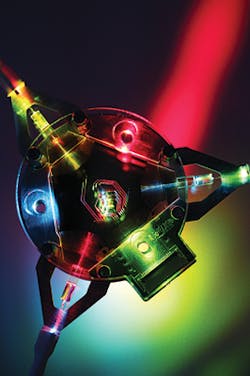Free-space Optical Communication: Datacenter cabling bottleneck cleared via free-space optical interconnects
With more than a million servers and thousands of racks of optical instrumentation, communications datacenters continuously grow in scale. Traditional datacenter networks use miles of fiber-optic cables connected to transceivers with integrated lasers and detectors—however, free-space optical (FSO) communication interconnects could offer relief from the complex and bulky cabling system (which can obstruct airflow and impose added cabling complexity if rack systems fail or need upgrading), as well as the relatively high power consumption of legacy intra-datacenter interconnect options.
Researchers from the National and Kapodistrian University of Athens, Athens Information Technology (AIT), the University of West Attica (all in Athens, Greece), Polytechnic University of Catalonia (Barcelona, Spain), LioniX International (Enschede, Netherlands), and Thales (Palaiseau, France) have, in response to these scalability and reconfigurability issues, designed FSO intra-datacenter interconnects based on two-dimensional (2D) optical beam steering enabled by photonic integrated circuits (PICs).1 These FSO PIC-based interconnects offer nanosecond-scale switching with submicrowatt power consumption, eliminate cabling concerns, and offer configuration flexibility.
OBS, PD arrays, and PICs
Using the LioniX TriPleX platform, a passive optical waveguide-based platform that operates over a broad wavelength range from 405 to 2350 nm, hybrid indium phosphide (InP)- and silicon (Si)-based electro-absorption modulators (EAMs) and semiconductor optical amplifiers (SOAs) control the output of an array of semiconductor tunable lasers. These outputs are then fed to electronically controlled optical switches and end with grating couplers, constituting a PIC transmitter array (see figure).To accomplish optical beam steering (OBS) of the transmitter array outputs (of which as many as 1000 pixels with 20 µm spacings are possible, with each pixel representing the output from an individual grating coupler), two mechanisms are used: wavelength tuning and pixel steering.
For wavelength tuning, a wide tuning angle of approximately 20° enables light emission from 1500 to 1580 nm. For pixel tuning, piezoelectric transducers (PZTs) reduce power consumption 1000X compared to thermoelectric devices (with submicrowatt consumption), and also offer nanosecond response times.
Each grating output beam is elliptical in shape, with divergence varying in the vertical (wavelength tuning) and horizontal (pixel steering) directions. To achieve the few-millimeter-sized beam waist to meet a 20 m run length and couple to a photodiode (PD) array, the beams that exit the gratings can be collimated using a variety of lensing options.
The optimum PD array to capture this collimated beam is a 25 GHz, 16 × 4 array of individual PDs with 250 µm center-to-center spacings to accommodate integrated coupling lenses and achieve an overall length of 4 mm. Use of a cylindrical lens dramatically improves coupling and reduces optical loss.
Communication between transmitter and receiver racks can be facilitated by configuring a cylindrically shaped cluster with the racks placed on the cluster’s border. An alternative approach to eliminate the line-of-sight requirement is to install mirrors on the ceilings of the datacenter to facilitate further interconnect options.
“LioniX International has developed several integrated circuits based on TriPleX, our proprietary silicon-nitride waveguide architecture,” says Paul van Dijk, vice president of strategy and innovation at LioniX International. “The complexity of the circuits can increase with better-quality waveguides and this platform provides record low-loss PICs that can be applied in a broad spectral range of applications such as optical coherence tomography, optical beamforming for phased-array antennas, and for FSO applications in datacenters or lidar. This datacenter application, elaborated by our colleagues from Athens, is a first step for optical communication and should be scalable to satellite communication and other LiFi applications.”
REFERENCE
1. C. Chaintoutis et al., MDPI Photonics, 5, 3, 21 (2018); www.mdpi.com/2304-6732/5/3/21/htm.
About the Author

Gail Overton
Senior Editor (2004-2020)
Gail has more than 30 years of engineering, marketing, product management, and editorial experience in the photonics and optical communications industry. Before joining the staff at Laser Focus World in 2004, she held many product management and product marketing roles in the fiber-optics industry, most notably at Hughes (El Segundo, CA), GTE Labs (Waltham, MA), Corning (Corning, NY), Photon Kinetics (Beaverton, OR), and Newport Corporation (Irvine, CA). During her marketing career, Gail published articles in WDM Solutions and Sensors magazine and traveled internationally to conduct product and sales training. Gail received her BS degree in physics, with an emphasis in optics, from San Diego State University in San Diego, CA in May 1986.

